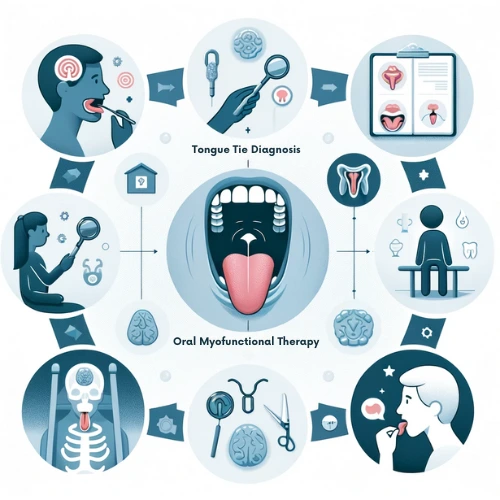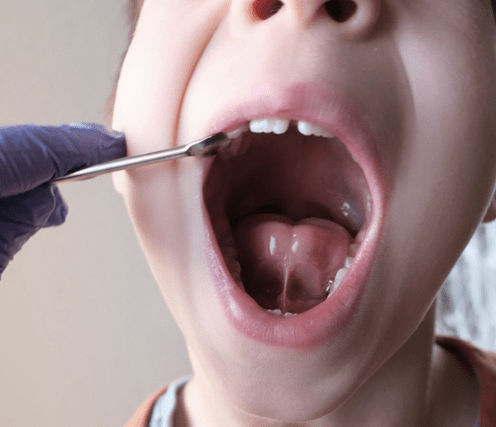Transform Your Smile: Discover the Truth About Tongue Tie!
Key Takeaways from the Article:
-
Understanding of Tongue Tie: Readers will gain a comprehensive understanding of what tongue tie (ankyloglossia) is, including its symptoms and impact across different age groups.
-
Insights into Myofunctional Therapy: The article provides detailed information about myofunctional therapy, its role in managing tongue tie, and specific therapeutic exercises.
- Oral Health Management Tips: Practical guidance on maintaining oral hygiene and making lifestyle adjustments for those dealing with tongue tie, especially from a dental hygienist’s perspective.

Beyond the Tip of the Tongue: Unveiling the Impact of Tongue Tie
Have you ever heard the words “tongue tied”? It usually makes people think of someone stumbling over their words, but it can also mean a real physical condition called ankyloglossia, or more commonly known and referred to as ”tongue tie.”. This condition is easily missed, but it can have a big effect on your oral health and general health.
There is a very thin band of tissue that serves as a leash and holds the bottom of your tongue to the floor of your mouth. It works like this when you have a tongue tie. It’s called the lingual frenulum, and this band can be too short or too tight, which limits the tongue’s normal range of motion. As a myofunctional therapist and dental hygienist, I see directly how tongue tie affects people. It can affect babies and make it harder for them to nurse properly, which can make them frustrated and cause them to gain less weight.
It can affect a child’s speech development and make it difficult for them to pronounce and articulate words. As an adult, you can still have problems with good oral care, chewing, and even jaw pain if you have a tongue tie.
Myofunctional therapy is a key part of controlling this condition and helping to ease the symptoms you are experiencing. We can help the muscles in the tongue and the frenulum stretch again by using gentle exercises and methods. This will allow the tongue to move and work normally again. This can make breastfeeding, speech development, and general oral health a lot better. But there are more perks than just health.
Getting past the restrictions of tongue tie can open up a lot of new options. Imagine a child learning new words with confidence, a parent eating without pain, or an adult feeling the freedom of unrestrained speech for the first time. These are just some of the life-changing effects that drive our efforts to understand and treat tongue ties.
That’s why the next time you hear the word “tongue tied,” keep that in mind. As a warning, the tip of the tongue has a lot of hidden potential, just ready to be used. A tongue-tie at a time, myofunctional treatment can help people regain their voices, smiles, and general health. Graphic Suggestion: An infographic outlining the role of myofunctional therapy in treating tongue tie.
Understanding Tongue Tie
Ankyloglossia, commonly known as tongue tie, occurs when the lingual frenulum, the tissue connecting the bottom of the tongue to the floor of the mouth, is unusually short or tight. This condition can restrict tongue movement, impacting various aspects of health, from speech to eating. While often identified in infants, tongue tie can affect individuals of any age, with a higher prevalence in males.
Symptoms of Tongue Tie
In its early stages, tongue-tie makes it hard for breastfeeding babies to feed themselves. Because of their limited tongue movement, it’s difficult for them to latch on properly, which makes them frustrated and makes it hard for them to get enough milk. This can make it hard for babies to gain weight and make feedings last longer, which is bad for both the mother and the baby.
It gets worse for kids with tongue ties as they get older. Speech problems often arise, especially with sounds that require exact tongue placement, like “s” and “th.” Lisping, stuttering, and trouble being heard properly can result from this. Also, a tongue that can’t move around much can stop the mouth and teeth from developing properly, which can cause problems with the bite and orthodontics.
Tongue tie can have an impact on oral health in addition to these physical restrictions. Because of the limited movement, it is difficult to brush and floss properly, leaving parts of the mouth open to plaque buildup and decay. This can make the problems that come with tongue-tie even worse, leading to a circle of pain and possible health problems.
But that’s not the end of the story. Similar challenges, such as speech stuttering and dental issues, are frequently experienced by adults with tongue ties. Because of their limited tongue movement, they may also have jaw pain, difficulty eating, and even problems speaking and playing wind instruments.
The condition known as tongue tie can, thankfully, be fixed. The frenulum, the band of tissue that keeps the tongue from moving, can be easily released through surgery. This can help a lot with speech, eating, and your general oral health, as well as get rid of pain.
The development of tongue tie, from its mild start in infancy to its possible impact later in life, shows how the human body is incredibly complex and interconnected. Early diagnosis and treatment of this condition can stop a chain of problems, letting people live their best lives with unrestricted speech, perfect dental health, and a confident smile.
Impact on Oral Health
Tongue tie can significantly affect dental health, contributing to malocclusions and misalignments due to improper tongue placement. It also hinders effective oral cleansing, increasing the risk of dental decay.
-
Difficulty in Cleaning: A tongue tie can make it hard for a person to brush food off their teeth and swallow completely. This means that food might stay in the mouth and cause problems.
-
Tooth decay and gum disease: If food stays in the mouth, it can lead to tooth decay and gum disease. This is because the food can break down and produce harmful acids that damage the teeth and gums.
-
Tongue-Thrust: People with tongue ties might develop a space between their lower bottom teeth. This is caused by tongue thrust, which is when the tongue pushes against the teeth when swallowing or speaking. This can affect the position of the other teeth in the mouth.
-
Speech Difficulties: Tongue tie can make it hard to make certain sounds. This can affect a person’s ability to speak clearly.
-
Breast-feeding Problems: Babies need to be able to move their tongue to breast-feed properly. If a baby has a tongue tie, they might not be able to do this. This can cause problems for the baby and pain for the mother.
-
Difficulty Swallowing Food: A tongue tie can make it hard to swallow food. This can make eating uncomfortable and less enjoyable.
-
Gap Between Teeth: A gap can form between the bottom front teeth when they come in. This is because the tongue tie can affect the position of the teeth.
For a more comprehensive list of suggestions, check out our article on dental hygiene tips.


5. Myofunctional Therapy: An Overview
Myofunctional therapy involves exercises designed to improve tongue mobility and strength. These exercises also aid in establishing proper oral resting posture, which is critical for speech and swallowing. Some of the main goals we strive for are to:
-
Eliminate Oral Habits: The therapy aims to stop habits like nail biting, thumb sucking, and lip licking. These habits can affect the shape of the mouth and teeth.
-
Improve Tongue Position and Tone: The therapy works to improve the position and tone of the tongue. This helps with speaking, eating, and breathing.
-
Improved Lip Seal: A good lip seal is when the lips can close comfortably without any effort. This is important for breathing and swallowing.
-
Promote Proper Swallowing and Chewing: The therapy teaches how to swallow and chew in a way that is good for the teeth and jaws.
-
Promote Nasal Breathing: Breathing through the nose is healthier than mouth breathing. The therapy works to correct mouth breathing.
-
Correct Dysfunctional Habits: The therapy helps to correct habits like grinding and clenching the teeth. These habits can damage the teeth and jaws.
-
Treat Sleep-Disordered Breathing: The therapy can help with problems like snoring and sleep apnea. These problems can affect sleep quality and overall health.
-
Improve Eating Function After Surgery: If a person has had surgery on their face or mouth, the therapy can help them learn to eat again.
-
Treat Speech Disorders: The therapy can help with speech problems caused by the tongue or lips not moving properly.
-
Treat Malocclusion: Malocclusion is when the teeth don’t fit together right. The therapy can help improve this, but it may also need other dental treatments.
Therapeutic Approaches in Myofunctional Therapy
Key exercises include tongue elevation and lateralization drills, lip strength exercises, and swallowing techniques. These help in achieving improved tongue functionality and oral health.
For a complete understanding of the services we offer at Paradigm Dental Therapy, with a focus on oral myofunctional therapy, you can visit our Oral Myofunctional Therapy page on our site.
The Role of a Dental Hygienist in Managing Tongue Tie
Dental hygienists are not only experts in oral hygiene; they are also important educators and collaborators on the path to better oral health, especially when it comes to the complicated problems associated with tongue tie management.
Plus, they know more than just how to clean teeth and do checkups; they can also help people with tongue ties learn how to take better care of their oral health. This includes tips on how to brush and floss properly that take into account the unique requirements of a limited tongue movement, ensuring that each patient has the best oral health possible.
They also play a big part in educating patients about how tongue ties can affect oral health over time and how important it is to get constant care. With their in-depth knowledge and attention to the patient, dental hygienists give people the tools they need to take charge of their oral health journey and turn difficulties into successes.
In a real sense, dental hygienists are more than just people who take care of people’s oral health. They are also teachers, collaborators, and supporters, especially when it comes to dealing with the unique problems that come up with tongue ties.


Lifestyle Adjustments and Oral Health Tips
Changes in food and good oral hygiene are not only helpful; they are necessary for getting rid of tongue ties for good. Customized methods are very important because this condition can make some eating habits painful and oral care hard.
To begin, adding softer foods to your diet can greatly reduce the pain that comes with eating. It can help to eat foods that are easy to move around in the mouth and don’t require as much chewing force, like steamed veggies, smoothies, and well-cooked grains. That doesn’t mean giving up taste or nutrition; it just means finding options that are easier on the tongue and still offer variety and pleasure.
Keeping up with a strict practice for oral hygiene becomes more important than ever at the same time. It might be hard for people with tongue ties to clean some parts of their mouth well. Certain ways of brushing, like tilting the brush to reach the back teeth and moving it gently in circles along the gum line, may work better. Also, using tools like water flossers, regular use of interdental picks, and toothbrushes with soft bristles can help clean your teeth thoroughly without hurting.
Professional dental care and personalized advice from a dentist can help you keep your oral health at its best. Also, they can show you how to change these methods as your condition gets better, especially if you’ve already had myofunctional therapy or other treatments for tongue tie.
In short, while tongue tie has its own unique challenges, changing one’s food and maintaining good oral hygiene can greatly reduce the severity of the condition and improve oral health.
One of the first steps is to get a certified professional to conduct an assessment if you believe you have a tongue tie or if your child or loved one is struggling with such a problem. In order to arrange an appointment with our clinic, please use this link to schedule your appointment when it is convenient.
Frequently Asked Questions: Tongue Tie and Oral Health
-
What is tongue tie (ankyloglossia)?
-
-
Tongue tie is a condition where the strip of skin under a baby’s tongue (lingual frenulum) is shorter than usual, which can restrict the tongue’s movement. This can cause difficulties with breastfeeding, speech, eating, and oral hygiene.
-
-
-
How common is tongue tie?
-
-
The prevalence of tongue tie varies but is estimated to affect between 4 and 11% of newborns. However, not all cases of tongue tie require intervention, as it depends on the severity and the associated symptoms.
-
-
-
What are the symptoms of tongue tie in infants?
-
-
In infants, tongue tie may present as difficulty latching during breastfeeding, poor weight gain, and a clicking sound while feeding. Mothers may also experience pain during breastfeeding and issues like mastitis or nipple damage.
-
-
-
Can tongue ties affect speech?
-
-
Yes, tongue ties can affect speech in some children. It can cause difficulties in articulating certain sounds like “l,” “r,” “t,” “d,” “n,” and “th.” However, not every child with a tongue tie will have speech problems.
-
-
-
What is myofunctional therapy?
-
-
Myofunctional therapy is a series of exercises that target the muscles of the mouth and face to improve breathing, bite, and speech. It is often used in conjunction with other treatments for tongue tie to improve oral function.
-
-
-
How Does Myofunctional Therapy Help with Tongue Tie?
-
-
Myofunctional therapy helps by strengthening and training the tongue and surrounding muscles. This improves tongue mobility and function, which is especially beneficial post-tongue tie release.
-
-
-
Is surgery always required for tongue ties?
-
-
Not always. The decision to perform surgery depends on the severity of the tongue tie and the symptoms it causes. Some cases can be managed with myofunctional therapy alone, while others might require a frenectomy (surgical release).
-
-
-
What Are the Long-Term Effects of Tongue Tie if Untreated?
-
-
If untreated, tongue tie can lead to speech difficulties, challenges with eating certain foods, dental issues like misalignment or increased risk of cavities, and, in some cases, social or emotional challenges due to these difficulties.
-
-
-
Can adults benefit from treatment for tongue ties?
-
-
Yes, adults can also benefit from tongue-tie treatment. Myofunctional therapy can be particularly beneficial for adults who have developed compensatory habits over the years.
-
-
-
What Should I Expect During a Myofunctional Therapy Session?
-
-
During myofunctional therapy, you’ll be guided through specific exercises that target the muscles used in swallowing, speaking, and breathing. These exercises are tailored to improve strength, coordination, and range of motion in the orofacial muscles.
-
-


